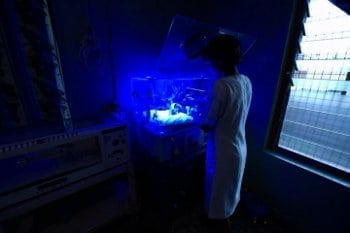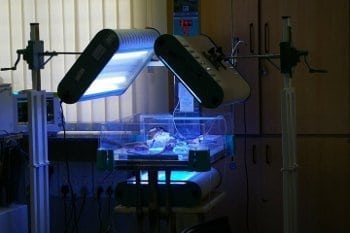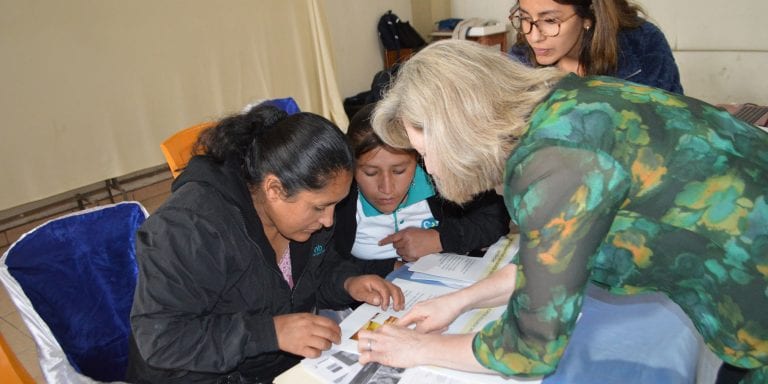
This photo, taken March, 2010 in Ogbomoso, Nigeria, shows the first baby to receive jaundice treatment by D-Rev’s cheaper, more power efficient device. Credit: Ben Cline
A design group has made a cheaper, greener blue light for treating jaundice. All it took was new bulbs and meticulous attention to details.
Jaundice afflicts at least 13 million babies every year, 9 million of whom are in developing countries. That number could be much higher: The disease easily goes undiagnosed, since the front lines of health care in impoverished communities are often home remedies and sparsely equipped clinics.
The tragedy—and the opportunity—is that jaundice has a simple cure: Blue light. Phototherapy chambers immerse a baby in high-intensity blue light to break down the bilirubin that accumulates in the blood of jaundiced babies.
Unfortunately, the machines are expensive for the world’s poor—about $3000. And they’re power hungry, so they continue to cost money to run.
D-Rev—Design Revolution—a non-profit design firm, has lowered both of those costs with an inexpensive, energy-efficient phototherapy device that it calls Brilliance. Lab tests at Stanford Medical Schools (one of D-Rev’s partners) showed that the new design provides jaundice therapy that equals or beats the quality of traditional devices and it costs a tenth of the price.
The savings are in the lights. Traditional machines use CFL (compact fluorescent light) bulbs, but D-Rev uses LEDs (light-emitting diodes) that cost less and last 10 times longer—30,000 to 50,000 hours. Then D-Rev precisely distributes and diffuses the lights to make the machine comply with the standards of the American Academy of Pediatricians.
“The approach we take with all of our products is that they are world class and can be used here [in the United States] as well as in Indian hospitals,” Krista Donaldson, who directs D-Rev, tells E4C. “We did very solid optical modeling to make sure that the light is diffused properly at the radiance level.”

To compensate for burned-out bulbs and poor bulb replacements, three conventional phototherapy devices are treating one baby in this hospital in Bengalore. D-Rev’s new phototherapy device could reduce this kind of inefficiency with its longer lasting bulbs that are cheaper to replace. Credit: Krista Donaldson
D-Rev is working with an Indian company, Phoenix Medical Systems, to help distribute their phototherapy device. Phoenix should start taking orders from Indian hospitals in early 2011.
D-Rev is developing a smaller, even more energy-efficient phototherapy device for rural clinics and as a backup or emergency option for urban hospitals. The device, “Comet,” performs as well as “Brilliance” in lab tests, Donaldson says. But it runs hotter and needs a handle. The design could be finished by June 2011.
Brilliance, if not its smaller cousin, has the potential to replace machines in developed world hospitals. The performance is on par or better than the machines in use now, and it’s cheaper and more power efficient. If that happens, however, it may not be for some time, Donaldson says. There are issues with intellectual property rights and bureaucratic challenges to equipping US hospitals, she says.
“If we came back to the West, we’d probably use the profits to to fund non-profit opportunities in places like India,” Donaldson says.
Resources
“Brilliance” at D-Rev’s site
“Brilliance” overview (pdf)

is there any side effect?